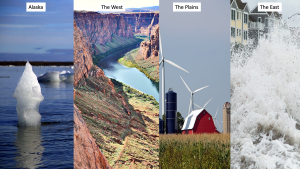How is a changing climate changing the way we interact with our landscapes, and what does the next century hold? This Quest 2 course will explore the impacts of climate change over the United States, starting with an overview of climate change science and the tools climate scientists use to measure and monitor climate change. We then move between four specific sub-regions of the country, identifying the cultural and historical contexts of these regions, how climate has varied in the ancient and recent past, how it may change in the future, and how these aspects both come together to inform how each region is responding to their changing environment.
The purpose of this course is to foster climate change literacy so that students are prepared to face arguably the most pressing challenge of the 21st century. This is accomplished through course content, activities, and assignments, that help students appreciate the scientific basis for climate change, and how climate change is impacting the places they know and care about. We explore the ways climate change is creating challenges, but also opportunities in terms of the ways we live and interact with our environment, and what is needed for effective adaptation to the hazards it poses. Students will be challenged to critically evaluate their own perceptions of climate change, as well as to appreciate the complexities in attempting to solve real world problems under a variety of plausible projections of future climate. This course spans both physical and social sciences, and therefore may appeal to students in a broad range of disciplines. Student evaluation will include some basic data analysis using online tools, a focus on competent written communication, and teamwork.
Please see the attached syllabus for course details: Mullens, People and Places Changing Climate Quest 2 SyllabusRevised2025
FAQ:
What skills and student characteristics are necessary to demonstrate/grow in this course?
- Critical thinking
- Ability to manage your time well
- Teamwork
- Good written communication skills
- Interest in the course content
- Creativity
Typically 85% or more students score A grades, but this course is not an ‘easy’ A – work and effort is necessary commensurate with any 3-credit hour course work (typically 3-hours in the classroom plus 2-4 hours outside of the classroom, weekly).
